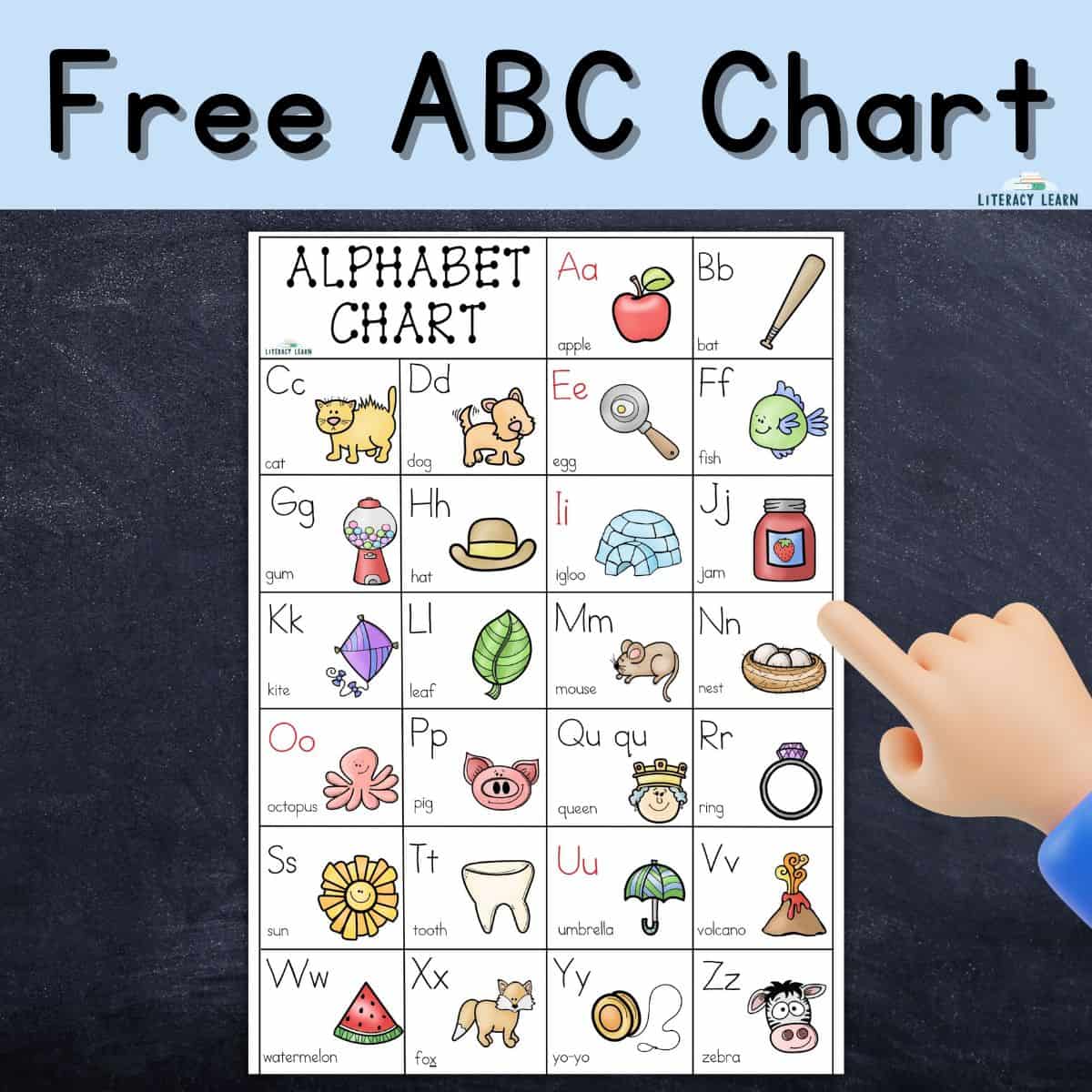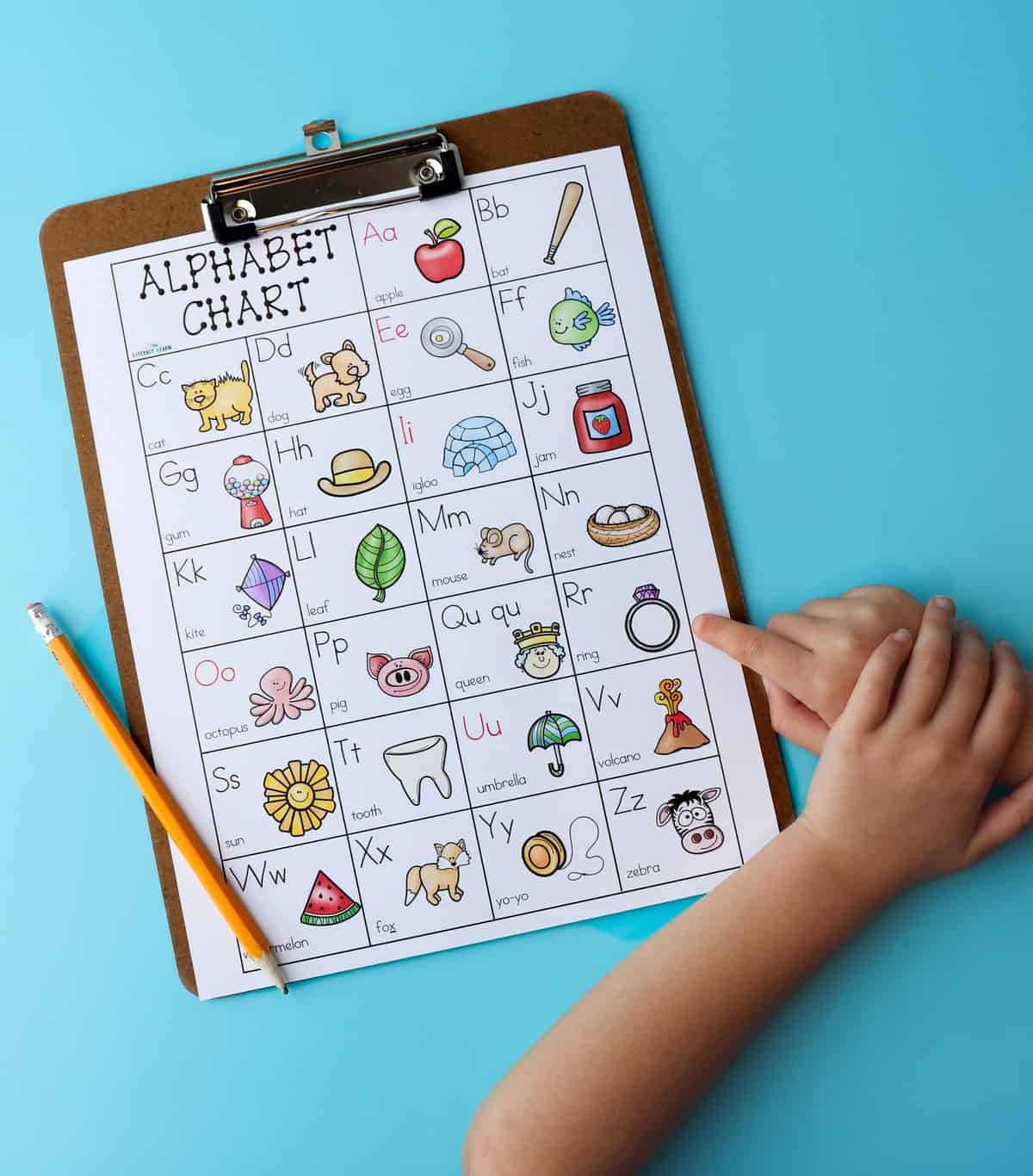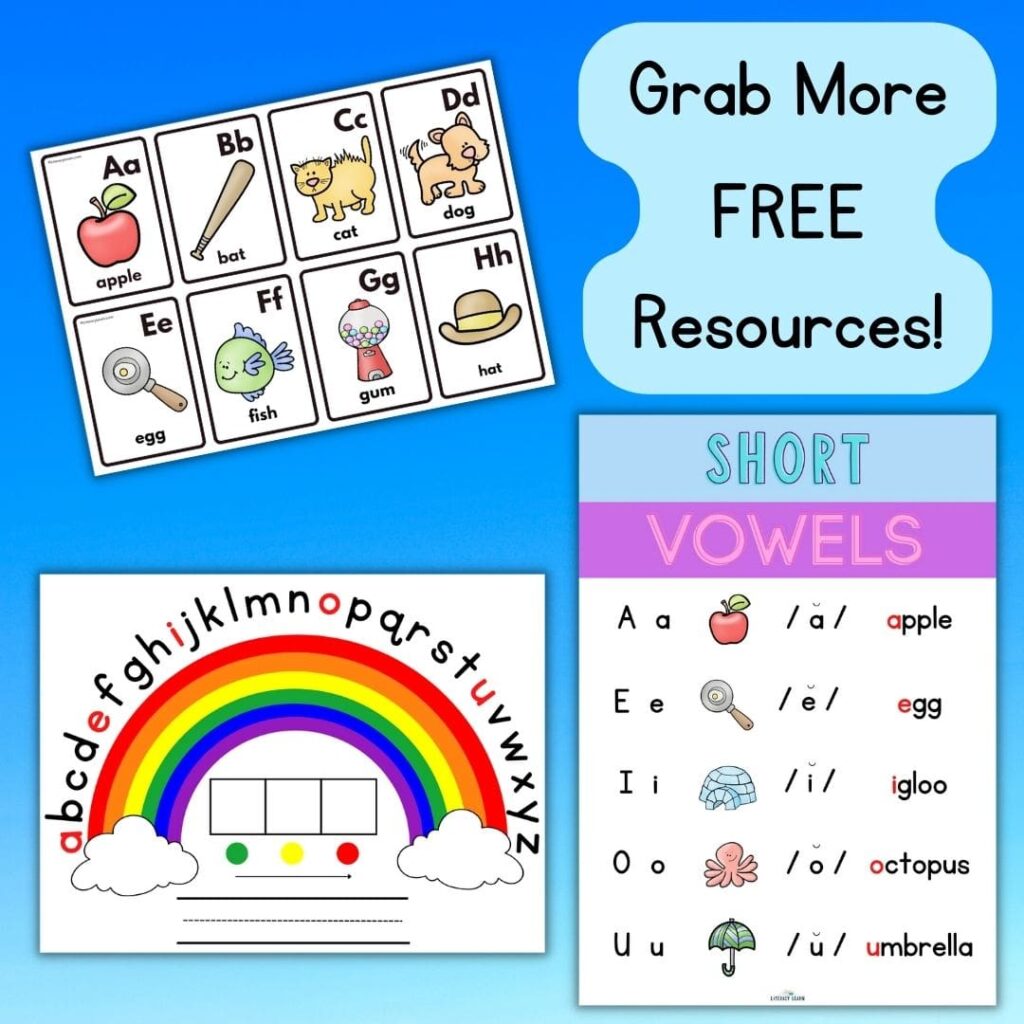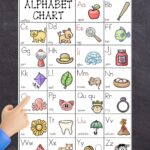Free ABC Chart: How to Use an Alphabet Poster
This post may contain affiliate links. As an Amazon affiliate, we earn from qualifying purchases.
This free ABC chart features the letters of the alphabet A-Z with capital and lowercase letters, bright matching pictures, and important keywords. Learn how to use an alphabet poster to make learning letters and sounds fun and effective!

🔤 What Is an Alphabet Chart?
An ABC chart, or alphabet anchor chart, is a visual support with all letters included. It is specifically designed to help young children learn letter recognition and letter sounds.
There are 3 important elements included on any useful alphabet chart:
- Letters
- Pictures
- Keywords
Letters
The ABC chart includes both capital and lowercase letters.
Research shows that most children know more capital letters than lowercase letters, due to environmental print and familiarity with names.
“When children know the uppercase letter, they are sixteen times more likely to know the corresponding lowercase letter (Jones, et. al., 2012, p. 3). This is why we teach them together!
We also want kids to understand the difference between consonants and vowels. On our printable chart, consonants are written in black font, and vowels are written in red font. This helps kids differentiate.
Young learners need to master the basics, so ABC charts should only include the most common letter sounds are included. Vowels should reflect short vowel sounds and consonants with multiple sounds should reflect hard consonant sounds only.
Use the 44 phoneme chart for more advanced students.
🛑 Look out and beware! Some resources might say like “G is for Giraffe” or “X is for Xylophone” or “C is for City” or “S is for Ship.”
Steer clear of these kinds of resources because they don’t represent the pure sounds of the letter! Kids need to become firm and master the most basic letter sounds before being introduced to higher-level phonics concepts (like soft sounds).
Pictures
Every alphabet chart should include a bright, easy-to-recognize picture displayed to correspond with each letter.
The picture serves as an anchor in their memory and helps kids to hear the sounds the letters represent at the beginning of each word.
This is an important building block for improving phonological awareness!
Keywords
Keywords are included on an ABC chart for a very important reason!
Even when students haven’t yet learned to read words, seeing words and pictures together helps young learners begin to understand the connection between written text and meaning. This makes an important speech-to-print connection.
When a child sees a picture of a ring, for instance, and sees the word ‘ring’ written beneath it, they begin to understand that written words are made up of individual letters.
Together, the letters form a word and convey meaning
For example: R 💍 = r + i + ng = ring.
We’ve intentionally chosen keywords with the letter sound at the beginning of the word (except for letter x), helping kids to hear and practice beginning letter sounds.

🧑🏫 How to Use an Alphabet Chart
Parents and teachers can use this chart to explicitly teach letters and letter sounds together. The basic procedure should be to point to each letter on the chart and repeat this sequence:
- Say the letter
- Say the keyword
- Say the sound
For example: a – apple- /ă/
Teachers and parents should model this often until children can do it independently.
The letters, keywords, and sounds for an alphabet chart are:
- A a – Apple – /ă/
- B b – Bat – /b/
- C c – Cat – /k/
- D d – Dog – /d/
- E e – Egg – /ĕ/
- F f – Fish – /f/
- G g – Gum – /g/
- H h – Hat – /h/
- I i – Igloo – /ĭ/
- J j – Jam – /j/
- K k – Kite – /k/
- L l – Leaf – /l/
- M m – Mouse – /m/
- N n – Nest – /n/
- O o – Octopus – /ŏ/
- P p – Pig – /p/
- *Qu qu – Queen – /kw/
- R r – Ring – /r/
- S s – Sun – /s/
- T t – Tooth – /t/
- U u – Umbrella – /u/
- V v – Volcano – /v/
- W w – Watermelon – /w/
- *X x – Fox – /ks/
- Y y – Yo-Yo – /y/
- Z z – Zebra – /z/
👉 Letter Q
Teach Qu together! We do this because the rule is: Never a Q, without a U. This is helpful for beginners as they learn to read and spell.
👉 Letter X
All letters match the beginning sound of the pictures and words except letter X, which is represented by two phonemes /k/ + /s/. This sound will never be used at the beginning of words. As such, the /ks/ sound is heard at the end of the keyword fox.
Teaching Ideas
“Make certain that the child is secure in his knowledge of the letters of the alphabet. The alphabet is the cornerstone for all reading and spelling.”
”The International Dyslexia Association Handbook (2019) p. 7
Use this ABC Chart along with these connected resources which were intentionally created to be used together. They include the same pictures and keywords for consistency.
- Printable phonetic flashcards (free printable): These flashcards are perfect for introducing new letters. Keep a deck of known concepts for review, and add the new letter cards to the deck once they’ve been explicitly taught! They’re also great to send home as a resource for parents!
- Short Vowel Sounds Anchor Chart (free printable: Grab this other awesome anchor chart which focuses just on vowels. Print the ‘short vowels’ poster and display near the alphabet chart.
- Match Letters to Pictures (free printable): Kids will get multi-sensory practice matching uppercase and lowercase letters with colorful beginning sound pictures. This helps build a solid foundation of alphabet knowledge!
- Alphabet Arcs: This phenomenal alphabet arc resource can be paired with the ABC chart to further build alphabet knowledge.

Can You Use a Sound Wall and Alphabet Chart?
If you’re wondering if you can use a sound wall AND alphabet chart together, the answer is YES!
An alphabet chart is used for teaching letter recognition and letter sounds, while a sound wall is used to teach the sounds (phonemes) and the various ways to spell those sounds (graphemes). You can certainly connect the two when teaching new letters!
Hang the ABC poster near the sound wall, but it should not appear on the actual consonant wall or vowel valley. Both can be used as scaffolds for kids in the same classroom.
Students with learning disabilities or EL students still working to master basic letter sounds and alphabet knowledge will use the ABC chart. Advanced students learning the 5 ways to spell the Long I sound will utilize the sound wall.
Learn more about using sound walls in the classroom.
Conclusion
Every child needs a visual ABC chart, whether in a classroom or at home. Having a chart as an anchor is a helpful tool for young learners as they practice and master letters and letter sounds.
This chart can be printed as big or as small as you’d like! You can enlarge it to hang on a wall or make it small enough to glue to a child’s notebook. Better yet, do both!
Be sure the chart is within clear view so that children can reference the alphabet often and have it handy whenever they need it.
References:
Jones, C., Clark, S., & Reutzel, D.R. (2012). Enhancing alphabet knowledge instruction: research implications and practical strategies for early childhood educators. Springer Science+Business Media.
International Dyslexia Association. (2019). IDA dyslexia handbook: what every family should know. Baltimore.
Recommended Resources
🖨️ Download & Print
DOWNLOAD TERMS: All of our resources and printables are designed for personal use only in homes and classrooms. Each teacher must download his or her own copy. You may not: Save our files to a shared drive, reproduce our resources on the web, or make photocopies for anyone besides your own students. To share with others, please use the social share links provided or distribute the link to the blog post so others can download their own copies. Your support in this allows us to keep making free resources for everyone! Please see our Creative Credits page for information about the licensed clipart we use. If you have any questions or concerns regarding our terms, please email us. Thank you!
We’d love to hear about your experience using this resource!
Please leave a comment below or tag us on Instagram @literacylearn!


Love this for my little boy to practice by
Hi Tigre,
So glad your son can use these!
Katie and Laura